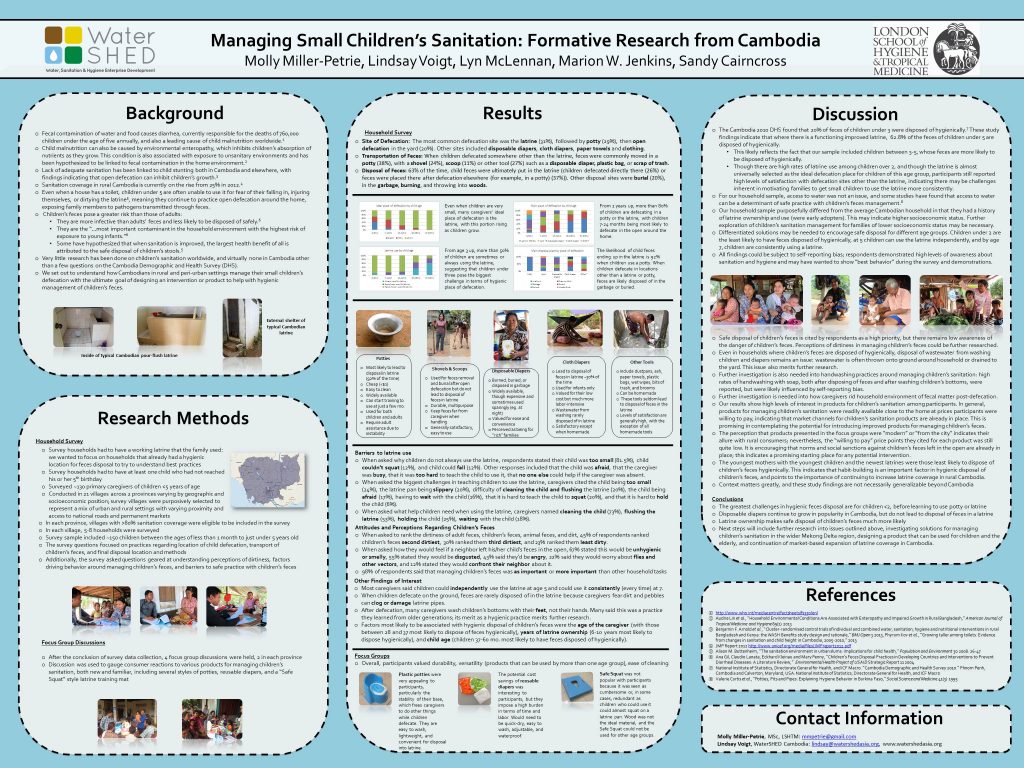UNC-2014 Poster: Infant & Young Children’s Sanitation
Download the poster
University of North Carolina Water & Health Conference (13-17 Oct 2014)
Title: Managing Infants’ and Young Children’s Sanitation: Formative Research from Cambodia
Authors: Lindsay Voigt, Behaviour Change Specialist, WaterSHED; Molly Miller-Petrie, MSc, London School of Hygiene & Tropical Medicine; Lyn McLennan, Program Manager, WaterSHED; Dr. Mimi Jenkins, UC Davis; Prof. Sandy Cairncross, London School of Hygiene & Tropical Medicine
Presenter: Lindsay Voigt, Behaviour Change Specialist, WaterSHED
Globally, the dangers of open defecation have been well documented. More recently, studies have shown inadequate sanitation to be associated with increased child morbidity and stunting in places as diverse as Bangladesh, Burkina Faso, Indonesia, Lesotho and Cambodia (Shordt 2006, Kov et al. 2013). These findings provide further impetus for promoting models such as market-based approaches that can accelerate sustainable access to safe latrines by virtue of improved efficiency and efficacy.
Even in the presence of an improved latrine, a significant population largely continues to practice open defecation in and around households: infants and young children. Many latrine designs are not suitable for use by small children, so it is easier for parents to allow them to defecate outside. Feces often remain in the open and children run the highest risk of direct contact and ingestion. This risk is compounded by the widespread perception in the developing world that children’s excreta are not dangerous, so concerns about safe dispose remain low. In reality, children’s feces are more infective than those of adults (Gil et al. 2004). Indeed, several studies have concluded that when sanitation is improved, the largest single factor contributing to improved health is the safe disposal of children’s stools (Buttenheim 2008; Ezzati et al. 2005; Shordt 2006; Yeager et al. 1999).
Despite the dangers posed to children, their families, and members of the wider community by continued open defecation by children near the home, surprisingly little research has been done in this field. In an effort to close the knowledge gap around children’s sanitation in Cambodia, WaterSHED, in conjunction with the London School of Hygiene and Tropical Medicine, undertook formative research on this topic 2014. The research aimed to gain a clear picture of how rural families in Cambodia manage their small children’s sanitation, as well as insight into the psychological and cultural drivers behind practices. Furthermore, the research sought to assess the market potential of products and services that aid in the safe management of children’s sanitation.
WaterSHED conducted household surveys with approximately one hundred and twenty caregivers of small children across diverse regions of Cambodia about managing their infants’ and small children’s feces. The surveys used closed and open-ended questions to uncover common practices and to draw out deeper psychological and cultural drivers of behavior, as well as barriers to practicing safe feces management with children. Focus group discussions with caregivers shed light on consumers’ reactions to a variety of available products for managing children’s sanitation.
Using the findings of this formative research, WaterSHED plans to identify market-based opportunities to promote products and/or services that can facilitate improved safe children’s sanitation management. As a step in understanding children’s sanitation management practices worldwide, a global search of enabling products was conducted, and an inventory was compiled of existing children’s toileting products, in order to help inform new product designs and offerings.

References:
Buttenheim, A. M. (2008). The sanitation environment in urban slums: implications for child health. Population and Environment 30, 26-47. (43)
Ezzati, M., Utzinger, J., Cairncross, S., Cohen, A. J., & Singer, B. H. (2005). Environmental risks in the developing world: Exposure indicators for evaluating interventions, programmes, and policies. Journal of Epidemiology and Public Health, 59, 15-22.
Gil, A., Lanata, C., Kleinau, E. and Penny, M. (2004) Children’s Feces Disposal Practices in Developing Countries and Interventions to Prevent Diarrheal Diseases: A Literature Review. Environmental Health Project of USAID Strategic Report 11, 1-67.
Kov, P. et al. (2005) Growing taller among toilets: Evidence from changes in sanitation and child height in Cambodia, 2005-2010. 1-26.
Shordt, K. (2006) HIP Review of safe disposal of feces. Hygiene Improvement Project (USAID) 1-27. (3),
Yeager, B. A. C., Huttly, S., Bartolini, R., Rojas, M., & Lanata, C. F. (1999). Defecation practices of young children in a Peruvian shanty town. Social Science & Medicine, 49(4), 531-541.
